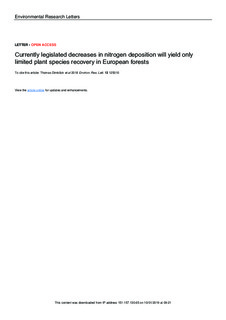Currently legislated decreases in nitrogen deposition will yield only limited plant species recovery in European forests
Dirnböck, Thomas; Pröll, Gisela; Austnes, Kari; Beloica, Jelena; Beudert, Burkhard; Canullo, Robert; De Marco, Alessandra; Fornasier, Maria Francesca; Futter, Martyn; Goergen, Klaus; Grandin, Ulf; Holmberg, Maria; Lindroos, Antti-Jussi; Mirtl, Michael; Neirynck, Johan; Pecka, Tomasz; Nieminen, Tiina Maileena; Nordbakken, Jørn-Frode; Posch, Maximilian; Reinds, Gert-Jan; Rowe, Edwin C; Salemaa, Maija; Scheuschner, Thomas; Starlinger, Franz; Uzieblo, Aldona Katarzyna; Valinia, Salar; Weldon, James; Wamelink, Wieger G W; Forsius, Martin
Journal article, Peer reviewed
Published version
Permanent lenke
http://hdl.handle.net/11250/2581890Utgivelsesdato
2018Metadata
Vis full innførselSamlinger
- Publikasjoner fra Cristin - NIVA [2149]
- Scientific publications [1172]
Sammendrag
Atmospheric nitrogen (N) pollution is considered responsible for a substantial decline in plant species richness and for altered community structures in terrestrial habitats worldwide. Nitrogen affects habitats through direct toxicity, soil acidification, and in particular by favoring fast-growing species. Pressure from N pollution is decreasing in some areas. In Europe (EU28), overall emissions of NO x declined by more than 50% while NH3 declined by less than 30% between the years 1990 and 2015, and further decreases may be achieved. The timescale over which these improvements will affect ecosystems is uncertain. Here we use 23 European forest research sites with high quality long-term data on deposition, climate, soil recovery, and understory vegetation to assess benefits of currently legislated N deposition reductions in forest understory vegetation. A dynamic soil model coupled to a statistical plant species niche model was applied with site-based climate and deposition. We use indicators of N deposition and climate warming effects such as the change in the occurrence of oligophilic, acidophilic, and cold-tolerant plant species to compare the present with projections for 2030 and 2050. The decrease in N deposition under current legislation emission (CLE) reduction targets until 2030 is not expected to result in a release from eutrophication. Albeit the model predictions show considerable uncertainty when compared with observations, they indicate that oligophilic forest understory plant species will further decrease. This result is partially due to confounding processes related to climate effects and to major decreases in sulphur deposition and consequent recovery from soil acidification, but shows that decreases in N deposition under CLE will most likely be insufficient to allow recovery from eutrophication.

